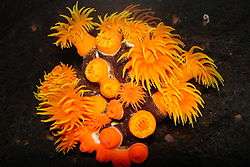Tubastraea
| Tubastraea | |
|---|---|
 | |
| Tubastraea coccinea | |
| Scientific classification | |
| Kingdom: | Animalia |
| Phylum: | Cnidaria |
| Class: | Anthozoa |
| Order: | Scleractinia |
| Family: | Dendrophylliidae |
| Genus: | Tubastraea [1] |
| Species | |
| |
Tubastraea, also known as sun coral or sun polyps, is a genus of coral in the phylum Cnidaria. It is a cup coral in the family Dendrophylliidae.
Description
Sun corals belong to a group of corals known as large-polyp stony corals. This means that while they produce a hard skeleton, they do not build reefs.[2] Different species have polyps in a variety of colors, including yellow, orange, and shades of black.
Feeding
Unlike most corals, Sun corals are not photosynthetic. Tubastraea do not host zooxanthellae, the symbiotic algae that provides energy to the coral via photosynthesis.[3] Instead, they are heterotrophic, and extend long tentacles at night to catch passing zooplankton.
Habitat
Tubastraea coccinea was first documented in 1943 on Caribbean reefs in Curaçao and Puerto Rico.[4] T. coccinea is an invasive species that was documented to have spread as far north as the Florida Keys National Marine Sanctuary in 2004.[4]
Tubastraea is often found in deep waters because they do not require sunlight for nourishment. They often colonize on artificial surfaces - such as ship wrecks - for this reason.[5]
Reproduction and Growth
Like most coral, sun coral reproduces asexually. They are hermaphrodites and produce planulae.[6] These larvae live for up to two weeks, but usually colonize within 1 meter (3.3 ft) of the parent organism.[7] They reproduce for approximately 1.5 years, growing about 3 cm² per year.[8]
In addition, Tubastraea form runners that can extend 10.4 centimeters (4.1 in) per year, until they reach unoccupied areas, then forming polyps at the end of the runner.[9]
Reproduction occurs sexually during the summer, spring, and winter seasons. After fertilization, the female corals will carry the eggs as the offspring develop within her gastrovascular cavity and are released as larvae. After being released, the larvae disperse and eventually settle on rocky seafloors "cementing" their skeletal structure to a rock. Once cemented, the coral will grow and reside there for the rest of its life.
Captivity
Tubastraea are difficult to keep in aquaria, because they require daily feedings of zooplankton. In addition, they extend their colorful tentacles only at night, further reducing their appeal.
References
- ↑ ITIS Standard Report Page: Tubastraea
- ↑ Hawaii Coral Reef Network. 2005. Family Dendrophyllidae: Cup Corals.
- ↑ Blomquist, C.H., Lima, P.H., Tarrant,A.M., Atkinson,M.J. and Atkinson, S. 2006. 17ß-Hydroxysteroid dehydrogenase (17ß-HSD) in scleractinian corals and zooxanthellae, Comparative Biochemistry and Physiology, Part B 143: 397-403
- 1 2 Shearer, TL (2009). "Population Analysis of an Introduced Coral Species, Tubastraea coccinea, in Florida". In: Pollock NW, ed. Diving for Science 2009. Proceedings of the American Academy of Underwater Sciences 28th Symposium. Dauphin Island, AL. Retrieved 2013-06-07.
- ↑ Fenner, D. and Banks, K. 2004. Orange Cup Coral Tubastraea coccinea invades Florida and the Flower Garden Banks, Northwestern Gulf of Mexico, Coral Reefs 23: 505-507.
- ↑ Ayre, D.J. and Resing, J.M. 1986. Sexual and asexual production of planulae in reef corals, Marine Biology 90: 187-190.
- ↑ Creed, J.C., Paula, A.F. De, 2007. Substratum preference during recruitment of two invasive alien corals onto shallow-subtidal tropical rocky shores. Mar Ecol Progr Ser 330: 101-111.
- ↑ Vermeij, M.J.A. 2006. Early life-history dynamics of Caribbean coral species on artificial substratum: the importance of competition, growth and variation in life-history strategy, Coral Reefs 25: 59-71.
- ↑ Vermeij, M.J.A. 2005. A novel growth strategy allows Tubastraea coccinea to escape small-scale adverse conditions and start over again, Coral Reefs 24: 442.